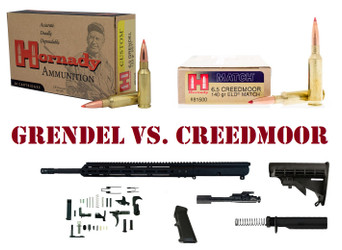6.5 Grendel vs. 6.5 Creedmoor
Posted by 80-Lower.com on Feb 16th 2021
The AR platform hosts loads of calibers. You're no longer stuck with old 5.56 NATO and .223 Remington, or .308 Winchester. Instead, new calibers in the 6.5mm range have allowed both the AR-15 and AR-10 (now sold as the LR-308) to outperform their respective ancestors. But what's the difference between these two rounds? What about ballistics? Most of all, which one should you build? AR kits and 80% lowers exist for both, but they each have advantages and disadvantages. To help you decide, we're comparing the two:
6.5 Grendel: What Is It?
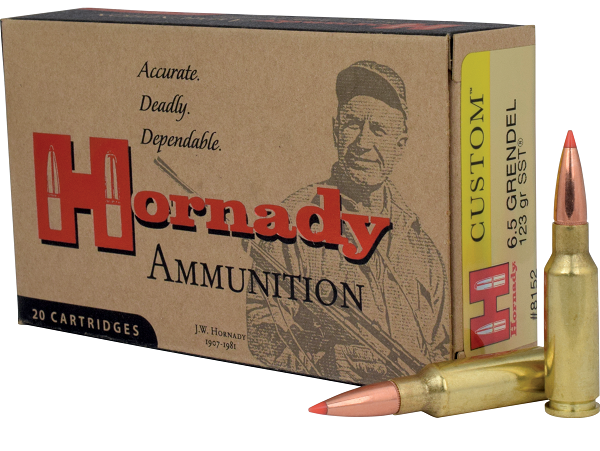
The 6.5 Grendel (6.5x39mm) is a high-performance, long-range centerfire rifle cartridge made to fit in the existing AR-15 platform with minor modifications. Its advertised effective range is approximately 800 yards. Across a spread of 90-grain to 130-grain loads, the round averages a muzzle velocity of 2,700 FPS with muzzle energy approximating 1,840 lb-ft. This data was generated using a 24" barrel. The Grendel cartridge is based on the 6.5 PPC, which itself was based off the .220 Russian, essentially a necked-down AK-47 (7.62x39mm) cartridge developed in the 1950s for deer hunting.
Bill Alexander, who designed the .50 Beowulf cartridge for the AR-15, created 6.5 Grendel to provide more stopping power for hunting American game. Alexander intended the Grendel round to be a direct upgrade over .223 Remington, the AR-15's original round, which many hunters felt was underpowered. The Remington's performance is also why the U.S. Military adopted 5.56 NATO after Vietnam. The Grendel provides similar velocity to .223 Remington, albeit with a much higher ballistic coefficient, or chance to hit at distance, while also providing approximately 50% more energy downrange.
(The Grendel's knock-off)
After its development, 6.5mm Grendel was trademarked by Alexander Arms until it was released to allow for SAAMI standardization. This trademark sparked the creation of a non-trademarked "clone" cartridge called .264 LBC. It is physically and ballistically the same as the Grendel but uses a different extractor.
6.5 Creedmoor: Brief History
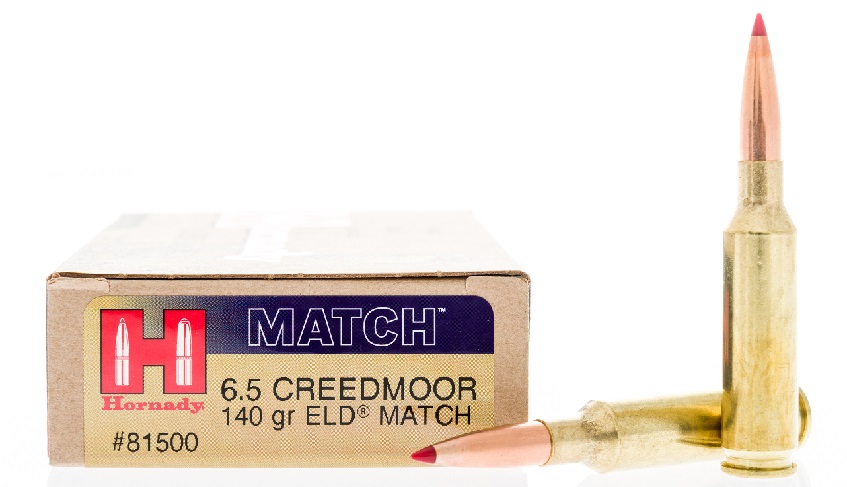
While Grendel cut its teeth on American game, the 6.5 Creedmoor (6.5x48mm) cartridge was developed in 2008 by Hornady specifically for competition shooting. Designers Dave Emary, who was then a ballistics scientist at the company and Dennis DeMille, an NRA High Power Rifle champ, were debating the merits of the wildcat 6mm XC cartridge, a repeating rifle round used in the NRA competitions. The duo wanted to create a load that had a higher BC than other 6mm loads, but with low chamber pressure and recoil and the ability to fit in the AR-10 platform.
Hornady took the .30 Thompson Center, a derivative of the .308 Winchester, as the base load for developing Creedmoor. With a short shell and 30-degree shoulder, the .30 TC could muster out the velocity required for a long-range 6.5mm load while still fitting in the relatively short action of the .308-based AR. The result was a cartridge that measures just 2.825" long with a max pressure of 62,000 PSI. Thus, Creedmoor yields the same SAAMI pressure specification as .308 Winchester while slinging a lighter and thus faster .264" bullet downrange. And the results are impressive for accuracy and distance.
Grendel vs. Creedmoor Cartridge Specs
Let's compare these two cartridges' physical specifications as a starting point for our comparisons:
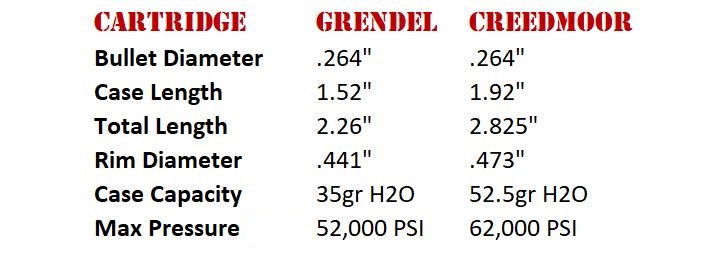
Both Grendel and Creedmoor use the same bullets. Grain weights vary between the two cartridges. Grendel typically uses lighter bullets (110-grain to 123-grain) than Creedmoor, which favors heavier loads approaching 125 to 140 grains. Regardless of weight, bullet diameter is the same. Creedmoor's case length is approximately 26% longer, which accounts for its greater capacity and thus, 19% increase in max pressure. It is this increase in capacity and pressure that allows Creedmoor to provide a higher ballistic coefficient at great distances when compared to Grendel.
Ballistics Compared
Let's dive into the hard data on what makes these two rounds perform so well at distance. We'll dive into energy, bullet drop, and velocity with different loads accounted for both cartridges. Let's start with raw energy from the muzzle to 500 yards downrange:

If we crunch some quick numbers, we find Grendel's 123-grain AMAX Match load retains about 48% of its muzzle velocity at 500 yards. Creedmoor's 120-grain ELD Match loads retain about 46% of muzzle velocity at 500 yards. Interestingly, Creedmoor's heavier 143-grain ELD loads retain 56% of muzzle velocity, winning this battle handily. Let's look at bullet drops for these loads next:

Combining both Creedmoor loads, we get an average bullet drop of 43" at 500 yards. Comparing to Grendel's 123-grain load, that's approximately 18% less drop, or about 10". Let's consider wind drift next. Drift is mostly affected by grain weight and not velocity, so the results may be interesting:

And they certainly are. We can see that both Creedmoor and Grendel loads weighing 120 and 123 grains, respectively, are just about even on wind drift, all the way from 100 to 500 yards. Variance only exists at 500 yards, and by only one inch. The heavier (and more wind-resistant) 143-grain Creedmoor load manages to reduce drift at 500 yards by about 25% compared to the former two loads. This is where Creedmoor's performance really begins to show compared to Grendel. After all, these two loads are otherwise pretty similar in their performance. That brings us to overall ballistic coefficients.
Ballistic Coefficients Compared
Ballistic coefficient, or BC, measures a rounds ability to overcome air resistance in flight. Essentially, it measures how well a bullet cuts through the atmosphere without being affected by the air (and wind) around it. The higher the number, the less drag the bullet experiences in proportion to its mass. Without getting into the nitty-gritty mathematics, this is how Grendel and Creedmoor tend to break down in the BC factor:
Grendel Loads
- Hornady 123-grain ELD: .506 BC
- Alexander 123-grain HPBT: .527 BC
- Federal 130-grain ELD: .530 BC
Creedmoor Loads
- Federal 130-grain Edge TRL: .545 BC
- Hornady 140-grain A-MAX: .585 BC
- Berger 140-grain Hybrid: .607 BC
For a "slightly fair" comparison, we can measure Grendel's and Creedmoor's 130-grain loads and find Creedmoor manages to eke out a ballistic coefficient that's about 3% greater. Not a huge difference in performance. Again, BC relies mostly on bullet weight and shape to reduce drag. Velocity and energy play secondary roles by merely contributing to a round's time of flight and its inertia of motion. Inertia measures a round's the tendency to continue at a particular speed and direction until forces act on it.
Max Effective Range
The end-all-be-all of comparing these two rounds: Which one can reach out and ring steel (or take game) the furthest? Obviously, Creedmoor wins in this case -- but not by much. For target shooting, Creedmoor's effective range is around 1,000 yards. Experienced hunters with the courage to take the shot can effectively kill at 600 yards with Creedmoor. The smaller 6.5mm isn't far behind:
Grendel's max effective range is about 800 yards. Hunters can expect to reliably snag game at 400 to 500 yards with this cartridge.
Grendel v. Creedmoor: AR-15 or LR-308?

By now you may be thinking, "Well, of course I'm going to go with Creedmoor over Grendel!" Except you must now also consider the weapon platform you prefer to build (or buy, if you don't want to be awesome and put together your own rifle kit). Picking 6.5 Grendel means you're building what is mostly a regular, ole' AR-15. If you opt for 6.5 Creedmoor, you're instead going to need to build an LR-308, the modern equivalent of the AR-10.
Q: Which rifle platform is better?
A: That depends on what you think "better" means. If you prefer an overall less expensive rifle that also affords greater customization and parts availability, the Grendel-chambered AR-15 is the clear winner. If you want to squeeze out every last yard of distance and build a hyper-accurate bench rifle, a 6.5 Creedmoor-chambered LR-308 is the rifle of choice.
Q: What about weight?
A: The average AR-15 (including one chambered in Grendel) weighs around 6.5 pounds. Considering Grendel requires a longer barrel than the average 16", you can assume your rifle will weigh around 7 to 7.5 pounds without optics. The average LR-308 rifle weighs around 10 pounds. But to maximize Creedmoor's velocity, it also requires a barrel that's longer than the average .308 rifle. So, add some weight here, bringing it to about 11 pounds.
This is a great segue into discussing rifle configurations. Let's dive into what you'd need to build an accurate 6.5mm rifle with either caliber.
Barrel Length
6.5 Grendel
Thankfully, Bill Alexander (remember him? He helped invent this smaller 6.5mm) gave a pretty clear-cut answer on what barrel length 6.5 Grendel needs to perform. He says it's 20 inches. That's not to say you can't squeeze out extra velocity by ramping up to a 24" barrel, which many shooters do. After all, those obsessed with precision downrange don't mind the extra length and weight. If all you're doing to punching holes in targets at 800 meters, the extra length might help with consistency. But 20" is generally ideal for obtaining max range with a rifle that doesn't weigh a ton.
JP Rifles conducted some tests with two Grendel rifles, so we can figure out just how much some extra barrel might help Grendel. They compared two guns with 18" and 22" barrels. Here's the velocity data they collected:

Jumping from a relatively short 18" barrel up to a 22-incher only yields an extra 7% or so in velocity for lighter loads. But importantly, for those interested in a higher BC, the heavier 129-grain SST load only gains 2.4% velocity by adding 4" of barrel. Keep in mind this is starting with an 18" barrel. Getting in the "Goldilocks" zone with a 20" barrel on a Grendel rifle will serve you well.
6.5 Creedmoor
Just as well, we've got some pretty hard evidence on what barrel length is required for Creedmoor to perform. The folks over at Rifle Shooter took a 27"-barreled rifle and tested Creedmoor's velocity by removing one inch of barrel at a time. They tested both 120-grain and 142-grain match loads to obtain a spread of data:
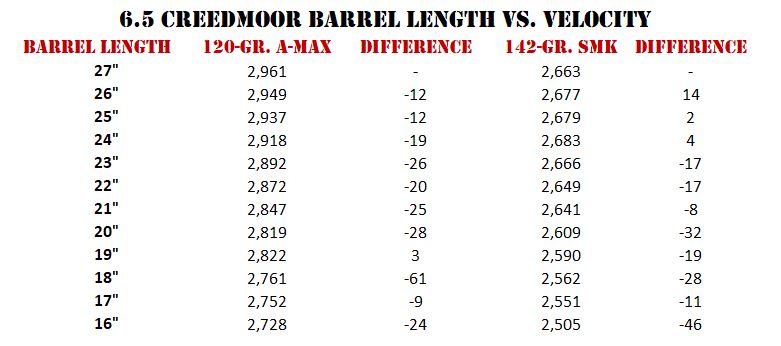
Some interesting things happen here, especially with heavier loads like the 142-grain Sierra Match King. As barrel length is reduced from 27" down to 24", velocity actually increases. This doesn't hold true for the lighter 120-grain load. But losses in velocity with this load are negligible even still: You're only losing a total of 43 feet per second, or about 1.5% when you cut down to 24 inches. Total loss in velocity for 120-grains remains below 100 FPS until you breach 21" of barrel. Ultimately, to obtain the most velocity and range with Creedmoor (utilizing loads with the highest BC) a 24" barrel is best.
Barrel Life
While on the topic of barrels, let's look at barrel life expectancy. This is usually a humorous topic when talking about building rifles. Virtually no AR owner is going to shoot out their barrel with a run-of-the-mill .308 or 5.56 setup. But these 6.5 loads run hot and fast. Long-range shooters are typically shooting enthusiasts (you have to get good, right?) so it is, in fact, possible to shoot out the barrel on either 6.5 load.
The Grendel manages about 5,000 rounds of barrel life. The Creedmoor only manages 2,000 to 3,000 rounds, depending on powder and grain weight. It is very easy to shoot 2,000 rounds or more, even in a year or so. If you're taking full advantage of either cartridge, you will eventually need to replace that steel. Keep in mind that for Creedmoor, that time arrives more up to 66% faster than Grendel.
Winner: Grendel
Magazine Compatibility

Since both 6.5 rounds use regular AR-type lower receivers, they must also use magazines that are compatible. The Creedmoor gets a leg up over Grendel, since it uses regular .308 magazines. The Grendel cartridge suffers from problems with feeding and chambering when 5.56/.223 magazines are used. It requires a different follower and spring, so Grendel magazines have to be specially made and usually cost more.
Winner: Grendel
Ammo Availability & Cost
Creedmoor ammo costs more. It also performs better and uses more powder and brass, so it makes perfect sense. 6.5 Crendel match loads can be had at retail for around $1.00 to $1.25 per round, while most Creedmoor match loads come in at around $1.50 to $1.75 per round.
Winner: Grendel
Receivers, Bolts, and Parts Kits

Q: What receivers do both Grendel and Creedmoor require?
Like we touched on in the beginning of our guide, if you opt for a Grendel build, you'll be buying an AR-15 upper and lower receiver, as well as an AR-15 lower parts kit. The typical 5.56/.223 barrel and extension gets swapped in the upper for a Grendel barrel and extension.
If you build a Creedmoor rifle, you'll be sticking with the LR-308 upper and lower. This is DPMS Panther Arms' modern equivalent to the AR-10. The LR-308 also uses an AR-15 lower parts kit while interfacing with an AR-10 bolt carrier and modified 6.5mm bolt. The .308 barrel extension get swapped the 6.5mm barrel and extension, while using an unmodified .308 upper and lower receiver.
AR-15 and .308 80% lowers can be used to complete these builds.
Q: Can I use a regular .308 AR bolt on my Creedmoor rifle?
A: No. The Creedmoor produces much higher pressure than .308 Winchester. Using a factory .308 bolt and firing pin will likely result in pierced primers and issues with functionality. The gas rings on the bolt may also fail early. An "HP" or high-pressure bolt and firing pin are recommended. A regular .308 bolt carrier is used with the "HP" 6.5 CM bolt. These Creedmoor kits come with HP bolts and pins to accommodate the higher pressure.
Q: What about an AR-15 bolt on a 6.5 Grendel rifle?
A: The same issues apply here, too: While the AR-15 carrier is used for Grendel builds, a Grendel-specific bolt is required to accommodate the higher pressures produced by this round, compared to 5.56 NATO and .223 Remington. You'll need something called a "Type 2" Grendel bolt.
Recap
There's a ton of info to consider when it comes to 6.5 Grendel and 6.5 Creedmoor, especially for the AR platforms. Here are the big things to remember if you choose to build one or the other:
- Both cartridges are 6.5mm and use .264" bullets.
- Grendel's max effective range is about 800 yards.
- Creedmoor's max effective range is about 100 yards.
- A Grendel rifle performs best overall with a 20" barrel.
- A Creedmoor rifle does best with a 22" to 24" barrel.
- The Grendel uses the AR-15 (.223) rifle platform.
- The Creedmoor uses the LR-308 (.308) platform.
DISCLAIMER: If you are new to the world of DIY gun building, you likely have a lot of questions and rightfully so. It’s an area that has a lot of questions that, without the correct answers, could have some serious implications. At 80-lower.com, we are by no means providing this content on our website to serve as legal advice or legal counsel. We encourage each and every builder to perform their own research around their respective State laws as well as educating themselves on the Federal laws. When performing your own research, please be sure that you are getting your information from a reliable source.

